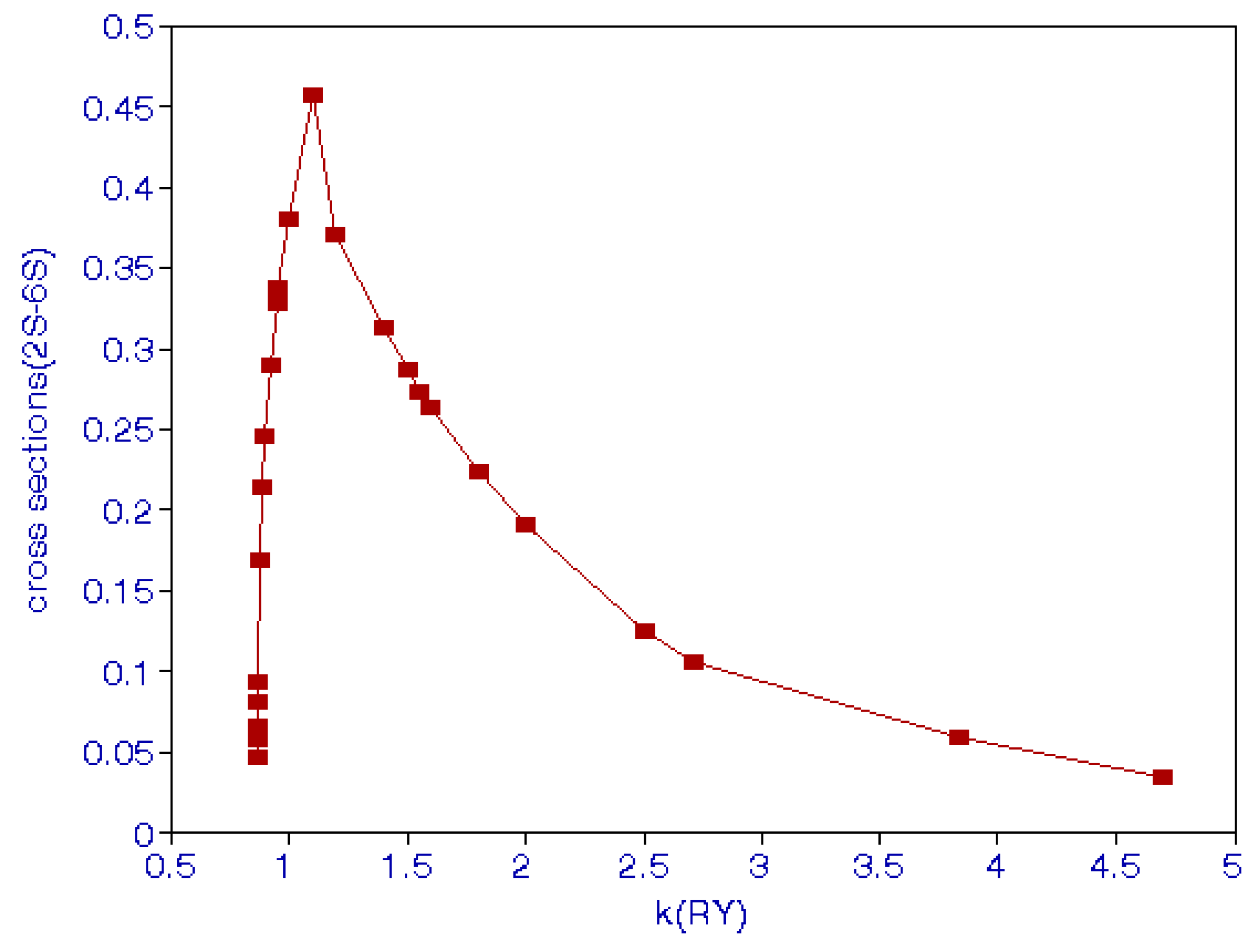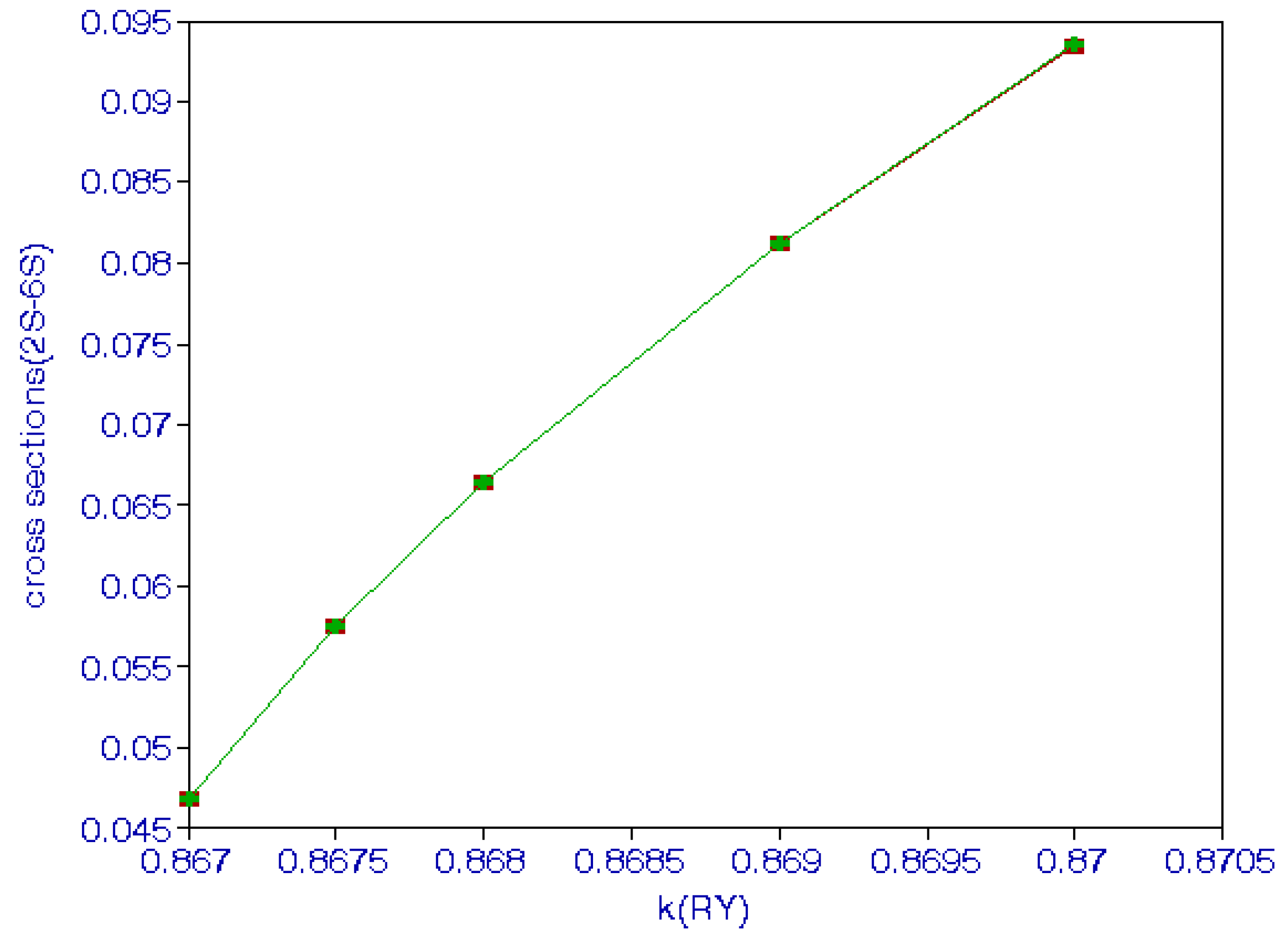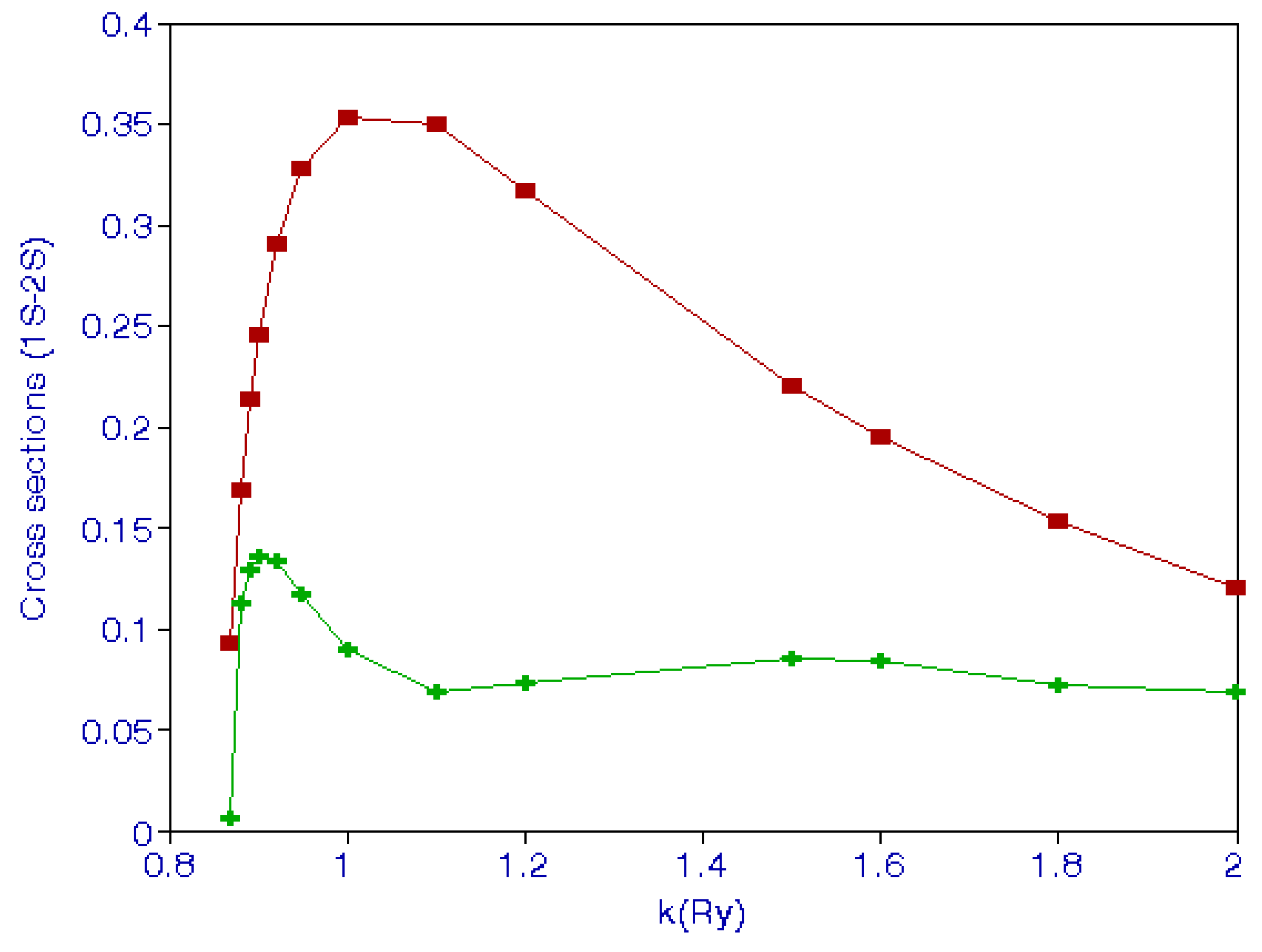Positron Impact Excitation of the nS States of Atomic Hydrogen
Abstract
1. Introduction
2. Theory and Calculations
3. Born Approximation
4. Results
5. Conclusions
Funding
Acknowledgments
Conflicts of Interest
References
- Dirac, P.A. In the Development of Quantum Theory; Gordon and Breach Science Publications: London, UK, 1971; p. 59. [Google Scholar]
- Anderson, C.D. The positive electron. Phys. Rev. 1933, 43, 1933. [Google Scholar] [CrossRef]
- Mackenzie, K.; Khooo, T.L.; McDonald, A.B.; Mckee, B.T.A. Temperature dependence of positron mean lives in metals. Phys. Rev. Lett. 1967, 19, 946. [Google Scholar] [CrossRef]
- Zhou, S.; Kauppila, W.E.; Kwan, C.K.; Stein, T.S. Measurements of total cross sections for positrons and electrons colliding with atomic hydrogen. Phys. Rev. Lett. 1994, 72, 1443. [Google Scholar] [CrossRef] [PubMed]
- Gien, T.T. Total cross sections for positron-hydrogen scattering. J. Phys. B 1995, 28, L321. [Google Scholar] [CrossRef]
- Walters, H.R.J. Positron scattering by atomic hydrogen at intermediate energies: 1s to is, is to 2s and 1s to 2p transitions. J. Phys. B 1988, 21, 1893. [Google Scholar] [CrossRef]
- Bhatia, A.K. Positron impact excitation of the 2S state of atomic hydrogen. Atoms 2019, 7, 69. [Google Scholar] [CrossRef]
- Burke, P.G.; Schey, H.M.; Smith, K. Collision of slow electrons and positrons with atomic hydrogen. Phys. Rev. 1963, 129, 1258. [Google Scholar] [CrossRef]
- Morgan, L.A. Positron impact excitation of the n = 2 level of hydrogen. J. Phys. B At. Mol. Phys. 1982, 15, L25–L29. [Google Scholar] [CrossRef]
- Sarkar, N.K.; Ghosh, A.S. Positron hydrogen scattering at low and medium energies using CCA. J. Phys. B 1994, 27, 759–779. [Google Scholar] [CrossRef]
- Bhatia, A.K. Hybrid theory of electron-hydrogen scattering. Phys. Rev. A 2007, 75, 032713. [Google Scholar] [CrossRef]
- Wigner, E.P. On the behavior of cross sections near thresholds. Phys. Rev. 1948, 73, 1002. [Google Scholar] [CrossRef]
- Sadeghpour, H.R.; Bohn, J.L.; Cavagnero, M.J.; Esry, B.D.; Fabrikant, I.I.; Macek, J.H.; Rau, A.R.P. Collisions near threshold in atomic and molecular physics. J. Phys. B 2000, 33, R93. [Google Scholar] [CrossRef]



| ki | 2S | 3S | 4S | 5S | 6S | Total |
|---|---|---|---|---|---|---|
| 0.867 | 4.68 (−2) | 4.68 (−2) | ||||
| 0.8675 | 5.75 (−2) | 5.75 (−2) | ||||
| 0.868 | 6.64 (−2) | 6.64 (−2) | ||||
| 0.869 | 8.12 (−2) | 8.12 (−2) | ||||
| 0.87 | 9.35 (−2) | 9.35 (−2) | ||||
| 0.88 | 1.69 (−1) | 1.69 (−1) | ||||
| 0.89 | 2.14 (−1) | 2.14 (−1) | ||||
| 0.90 | 2.46 (−1) | 2.46 (−1) | ||||
| 0.92 | 2.90 (−1) | 2.90 (−1) | ||||
| 0.95 | 3.28 (−1) | 8.90 (−4) | 3.28 (−1) | |||
| 0.96 | 3.35 (−1) | 1.39 (−3) | 3.37 (−1) | |||
| 1.00 | 3.53 (−1) | 2.60 (−3) | 5.94 (−4) | 2.32 (−2) | 3.86 (−5) | 3.79 (−1) |
| 1.10 | 3.50 (−1) | 4.27 (−3) | 9.09 (−4) | 1.02 (−1) | 3.30 (−4) | 4.57 (−1) |
| 1.20 | 3.17 (−1) | 5.20 (−3) | 1.01 (−3) | 4.71 (−2) | 6.00 (−4) | 3.71 (−1) |
| 1.40 | 2.50 (−1) | 6.03 (−3) | 1.15 (−3) | 5.40 (−2) | 1.97 (−3) | 3.13 (−1) |
| 1.50 | 2.20 (−1) | 6.12 (−3) | 1.19 (−3) | 5.62 (−2) | 2.62 (−3) | 2.86 (−1) |
| 1.55 | 2.05 (−1) | 6.18 (−3) | 1.21 (−3) | 5.72 (−2) | 2.77 (−3) | 2.72 (−1) |
| 1.60 | 1.95 (−1) | 6.19 (−3) | 1.23 (−3) | 8.13 (−2) | 2.98 (−3) | 2.63 (−1) |
| 1.80 | 1.53 (−1) | 6.07 (−3) | 1.24 (−3) | 5.91 (−2) | 4.43 (−3) | 2.24 (−1) |
| 2.00 | 1.21 (−1) | 5.83 (−3) | 1.18 (−3) | 5.68 (−2) | 5.09 (−3) | 1.90 (−1) |
| 2.50 | 7.13 (−2) | 5.11 (−3) | 8.97 (−4) | 4.36 (−2) | 4.39 (−3) | 1.25 (−1) |
| 2.711 | 5.83 (−2) | 4.80 (−3) | 7.76 (−4) | 3.77 (−2) | 3.66 (−3) | 1.05 (−1) |
| 3.834 | 3.24 (−2) | 3.30 (−3) | 4.32 (−4) | 2.05 (−2) | 1.26 (−3) | 5.85 (−2) |
| 4.696 | 1.51 (−2) | 2.41 (−3) | 3.52 (−4) | 1.66 (−2) | 4.33 (−4) | 3.49 (−2) |
| E (eV) | A a | B b | C c | D d | E e | F f |
|---|---|---|---|---|---|---|
| 54.4 | 3.54 (−1) | 2.62 (−1) | 6.16 (−1) | 1.37 | 3.02 | 2.85 |
| 100.0 | 2.15 (−1) | 1.05 (−1) | 3.20 (−1) | 9.80 (−1) | 2.24 | 2.00 |
| 200.0 | 9.58 (−1) | 5.85 (−2) | 1.54 (−1) | 6.28 (−1) | 1.33 | 1.24 |
| 300.0 | 8.18 (−2) | 3.49 (−2) | 1.17 (−1) | 4.65 (−1) | 9.69 (−1) | 8.73 (−1) |
| ki | Cross Section | ki | ki | Cross Section | Cross Section |
|---|---|---|---|---|---|
| 0.867 | 4.23 (−2) | 0.92 | 3.11 (−1) | 1.55 | 3.30 (−1) |
| 0.8675 | 5.21 (−2) | 0.95 | 3.77 (−1) | 1.60 | 3.13 (−1) |
| 0.868 | 6.03 (−2) | 0.96 | 3.93 (−1) | 1.80 | 2.53 (−1) |
| 0.869 | 7.40 (−2) | 1.00 | 4.42 (−1) | 2.00 | 2.08 (−1) |
| 0.87 | 8.56 (−2) | 1.10 | 4.82 (−1) | 2.711 | 1.15 (−1) |
| 0.88 | 1.61 (−1) | 1.20 | 4.66 (−1) | 3.834 | 5.75 (−2) |
| 0.89 | 2.10 (−1) | 1.40 | 3.88 (−1) | 4.696 | 3.83 (−2) |
| 0.90 | 2.50 (−1) | 1.50 | 3.49 (−1) |
© 2020 by the author. Licensee MDPI, Basel, Switzerland. This article is an open access article distributed under the terms and conditions of the Creative Commons Attribution (CC BY) license (http://creativecommons.org/licenses/by/4.0/).
Share and Cite
Bhatia, A.K. Positron Impact Excitation of the nS States of Atomic Hydrogen. Atoms 2020, 8, 9. https://doi.org/10.3390/atoms8010009
Bhatia AK. Positron Impact Excitation of the nS States of Atomic Hydrogen. Atoms. 2020; 8(1):9. https://doi.org/10.3390/atoms8010009
Chicago/Turabian StyleBhatia, Anand K. 2020. "Positron Impact Excitation of the nS States of Atomic Hydrogen" Atoms 8, no. 1: 9. https://doi.org/10.3390/atoms8010009
APA StyleBhatia, A. K. (2020). Positron Impact Excitation of the nS States of Atomic Hydrogen. Atoms, 8(1), 9. https://doi.org/10.3390/atoms8010009




